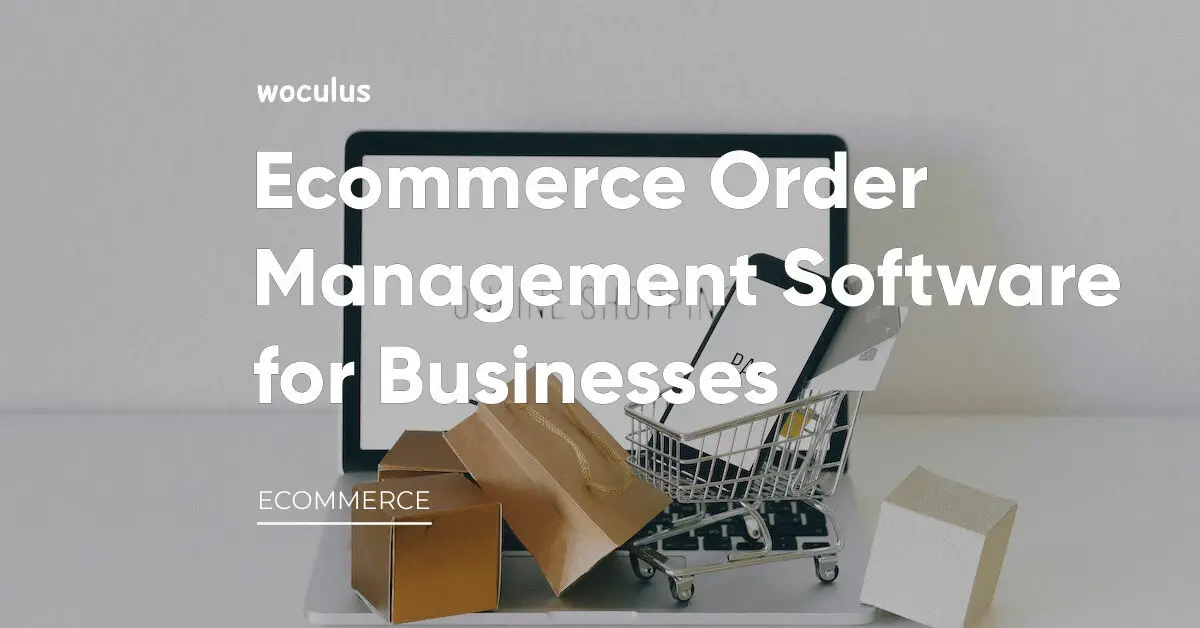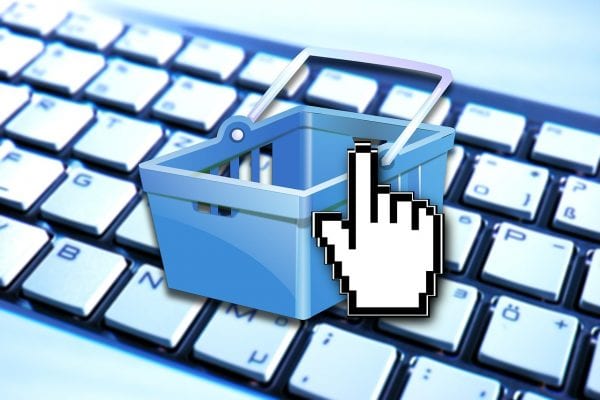Having the best e-commerce order management system can help improve the reputation of your business and the overall customer experience. While some small business still manages their orders manually by keeping records in ledgers and papers, large e-commerce companies often make use of an order management system because they handle more orders than small businesses which can be a little challenging. Therefore, as your business grows your online e-commerce store must invest in an order management system to help you centralize your order processing across different sales channels and fulfilment methods. This will help you automate your workflows and improve customer experience.
If you are looking for some of the best order management systems for your e-commerce business, then this article is just for you. The article will introduce some of the best order management system platforms to choose from for your business.
What is an Order management system?
An e-commerce order management system is simply the process of tracking orders from the initial purchase transaction, through the entire fulfilment process, to the point a customer receives their goods. It is a platform that helps e-commerce businesses track sales, orders, inventory, and fulfilment. An order management system helps e-commerce businesses manage and automate their online store order fulfilment process.
At each stage of the customer’s journey, data is being collected to ensure that customer orders can be tracked through the entire cycle. An e-commerce order management help businesses automate repetitive work, sync customer data across platforms and give clear details about current inventory levels and sales performance across multiple channels.
An order management system should consist of Customer communication, sales via multiple channels, tracking inventory and supply chains, logistics and third-party logistics and Customer service.
Without a proper order management system, the whole order process can quickly become complex and overwhelming, especially when managing orders across multiple channels and distribution centres. Consider an order management solution (OMS) to handle your orders more productively and generate higher profits.
Top 5 Order Management System
- Veeqo
- Brightpearl
- Netsuite
- ZOHO
- Magento
1. Veeqo
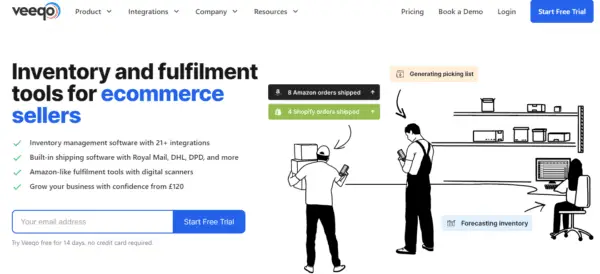
Veeqo is an all in one order management system platform that gives users visibility and control over their orders, inventory, packing, shipping, purchasing and reporting. The system receives order information from each sales channel and combines it within one online dashboard. It comes with 30+ e-commerce and shipping integrations. Orders can be tagged to make filtering and assortment of orders easy. With Veeqo, you can import orders from other stores and export your order to accounting software. Veeqo directly integrates with Royal Mail, USPS, FedEx, Amazon, Shopify, Magento, Etsy and 25+ more services, marketplaces and platforms.
Features
- Inventory management
- Integrate with different platforms
- Inventory Control
- Product Management
- Inventory Insights.
- Inventory Automation.
- Barcode Scanner & App.
- Order management
- Ecommerce shipping software
- Reporting & forecasting tolls
Pricing
- Accelerator- $195 per month
- High Growth- $253 per month
- Premium- $325 per month
- Enterprise- Custom Pricing
2. Brightpearl

Brightpearl is an eCommerce order management software that helps manage inventory, orders, customers, and finances. It also allows you to integrate orders from multiple channels and creates accounting journals automatically. The platform help collate information from various sales channels and pools it into one dashboard. You can use its advanced order fulfillment settings to automate pre-selling, split or partially fill orders, and manage backorders.
It also comes with an inbuilt CRM which helps users identify where and how a customer bought certain items. It contains basic contact information customer service teams would need to handle support queries.
Features
- Easy automation
- Real-time forecasting, accurate reporting
- Easily manage orders
- Automation feature for repeated orders
- Sales reports
- Partial fulfillment, drop shipping and other complex fulfilments are done with ease
Pricing
Cost is customized. Pricing.
3. Netsuite
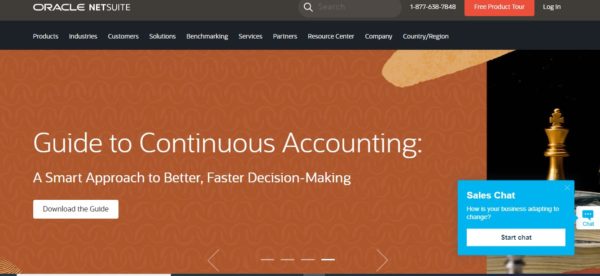
NetSuite is a cloud-based oracle’s Inventory and order management system designed specifically for eCommerce businesses. It is a very efficient platform that makes the task of order management extremely easy for you. It also takes care of your orders immediately from when they are placed to the time they reach the customer. It does this with the help of some amazing automation features.
Features
- Real-time visibility of inventory
- Analytics Features
- Billing management & invoice generation
- Sales Order Management
- Returns Management
- Buy, Fulfill or Return from anywhere.
- The whole order management process can be automated.
- On-time delivery of orders.
- Direct shipment from warehouses, store fulfillment, drop-ship, and continuity/subscription features.
- Establish customer and currency-specific pricing to maximize your profits.
Pricing
- Starts at $499 per month
4. ZOHO
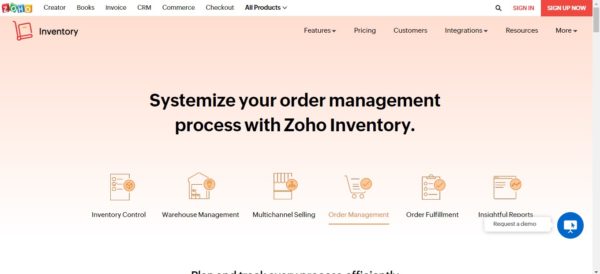
ZOHO is another cloud-based inventory and order management system for e-commerce businesses that help you manage your orders across multiple channels. It also controls your incoming orders and processes them at ease efficiently.
Features
- Track orders and inventories
- Integration with multiple sales channels like Amazon, eBay and Shopify
- Multi warehouse management, invoicing, and digital payment options.
- Fulfilling backorders and drop shipments.
- Centralized order management system
- Label generation
- Send updates to your customers about their orders.
Pricing
- It comes with a free version
- Basic- $39 per month
- Standard- $79 per month
- Professional- $199 per month
5. Magento
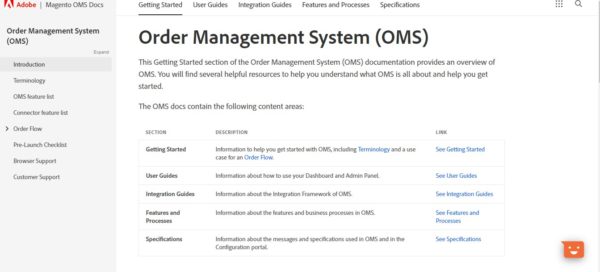
Magento order management allows you to sell or fulfil orders from anywhere and creates smooth cross-channel experiences. It also gives users control over their inventory and uses configurable sourcing rules to help determine the best location for products. With Magento, users can track orders, modify custom product attributes, automate refunding and cancel returns.
Features
- Integrated checkouts,
- Track and manage inventories across multiple channels.
- Centralized Customer Service
- Payment and shipping support,
- Optimized shopping for mobile devices,
- Catalogue management
- Integrate with Magento Marketplace extensions.
Pricing
Refer to Website for customized pricing.
Features of An Order Management System
1. Integrations
One thing to look for when choosing an order management system is its ability to integrate and sync data with other platforms. An order management tool should let you manage sales across multiple platforms by integrating with different channels which allow you to manage all your orders from one single dashboard. Most order management systems will incorporate customer service, warehouse, accountancy and inventory. However, you should consider a platform that allows more niche retail-based integrations. For example, an integrated CRM can offer opportunities for analysis of customer order history. It lets you sync data with your other platforms such as sales channels, fulfilment partners, financial systems, and POS.
2. Automation
One reason why people make use of an OMS is that it reduces the manual and repetitive work you need to do. The fewer manual processes, the better. The manual process is prone to error, especially with big businesses that have to deal with multiple orders daily. An order management system provides automation from calculating shipping costs to sending fulfilment requests. An order management platform should allow users to create multiple automated fulfilments to support different stages of the order cycle. Also, the logistics of shipping a product to a customer can be handled by a competent OMS in seconds.
3. Reporting
An OMS can help you track your performance and note any issue by providing insights on the product offered and customers that purchase those products. You can get valuable insight into your product and customers by using report analytics and business intelligence.
By combining real-time sales and performance data, a good quality OMS can supply your team with the relevant insights to streamline their processes. Better decisions are made when they are supplied with metrics that are relevant to their roles.
4. Inventory Management
An Order management system should allow you to update inventory levels across systems and sales channels. It should allow users to maintain and change inventory amounts, pricing, bin locations and status. As changes are made and orders are processed, the OMS platform should accurately update all aspects of inventory. An order management system should also allow users to add kit components and personalization templates. Additionally, these updates should occur in real-time to ensure the order fulfilment process is smooth and error-free.
5. Customer Support
An average order management system should be able to help with technical issues when handling large order volumes and related customer information. Businesses and companies need an order management system that offers solutions to some order issues they might be facing. They should be able to notify the user when an issue arises in the order process. The average order management system also helps track customer activity to gain more information about specific customers and reduce fake orders or fraudulent payments. Customer support helps businesses and companies increase customer satisfaction.
Why You Need An E-commerce Order Management System
1. Reduces Errors
An order management system will allow users to make fewer errors when taking orders. Instead of manually keeping track of incoming orders in an excel sheet, an OMS directly fetches data from your website and inventory to give you a holistic view of your current incoming, processed, and pending orders.
2. Increase Order Efficiency
Processing orders manually through the use of spreadsheets can be time-consuming. It makes you prone to errors that are not good for business. An OMS can increase the efficiency of your order management process by automating many steps that previously required manual involvement. This generally saves time as the company can process orders more efficiently and quickly. This will in turn, turn leads to customer satisfaction and enhance your cash flow and profit.
3. Manage multiple channels from one dashboard
An order management system allows you to integrate all channels like Amazon, Shopify, eBay and others into one and process orders as one unit. This helps you keep a single view across all channels.
4. Meet customer expectations
An OMS helps companies meet customer expectations. When it comes to shipping, most consumers will want to know the process of their order, including timing and location. Statistics show that 97% of customers expect to have insight into the status of their order including its current location and estimated delivery date. Most OMS platforms have built-in tracking pages to give customers an update on their order (or return) when requested.
How Does An e-commerce management system work
The process of an e-commerce management system begins when
- A customer places an order either online through the company website, in-store, or over the phone with a customer services representative.
- The business logs and accepts the purchase order and store the customer’s information including order history, the volume of orders, and payment preferences. They do this either manually or through order management software.
- The customer receives confirmation through email or phone or on the company’s website that their order has been received and payment has been made. Customers might receive a delivery estimate or a link to track their order.
- A sales order is generated, and items from the order are allocated to it from a company’s inventory. This process can be manual or through OMS automation.
- The order details are then sent to the company’s warehouse where stock levels are checked to know if the product is available. Then the goods are picked, packaged, and shipped by the warehouse team.
- Customers receive confirmation that their order has been dispatched. The company might also supply information to track orders through the delivery process at this stage.
- The customer receives their purchase, and checks are made to assure that the customer is satisfied with the product.
- If there is a problem, the customer raises an issue by contacting the business on phone, through email, comment on social media or through the company’s website.
- The customer’s issue is either resolved by providing a replacement product, issuing a refund, or offering other solutions. Here, a company must account for the inventory or financial implications of resolving the issue.
- The company can now reach out for a customer review.
How To Choose The Right OMS For Your E-commerce Business
You need to choose an order management system that best suits your business goals and objectives. Choosing the best platform will not only reduce your inventory management costs but streamline your order processing and keep your inventory up to date.
When choosing your e-commerce order management system, you have to
1. Understand your goals and objectives
like any other e-commerce marketing tool, there is a need for you to identify your goals and objectives and how these tools can help you achieve them. You can list some of the things you want to achieve during the process of your order cycle. Then search for platforms that have about 2/3 of those functions. You must also determine how quickly you would like to implement your OMS and assess providers that offer the best features that you need.
2. Select vendors based on their features, integrations and services.
You have to research and review some order management system platforms based on their capabilities and how they match with what you want to use them for. You can also check reviews and case studies from reputable merchants and businesses like your own.
3. Reach out to vendors to try a demo or free trial
You can reach out to most platforms and sign up for a demo or free trial. Through this process, you can test if you are making the right decision by testing if the platform
- Allows you to eliminate manual processes
- Support multiple warehouse locations
- Manage sales across multiple channels, currencies, and geographies
- Provides real-time inventory updates
- provides customer service
- Integrates with other channels
- Adds new features
The above information will help you make the best decision on choosing the best order management system. Furthermore, the right OMS will help you save time, cut costs, and deliver better experiences to your customers. Put together your top order management system, evaluate whether your options have the essential features your business needs, and ask vendors for guidance on implementing the new OMS.
Conclusion
The online retail world can be a very competitive one. For your business to survive in this kind of world, you have to implement various tools that will help your e-commerce business get ahead of your competition. One of these tools is the order management system platform. A good OMS platform can optimize the speed and accuracy of order processing which in turn can positively impact the customer experience, giving your business an edge over its competitors.

